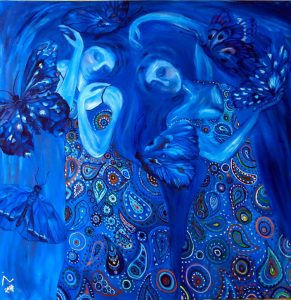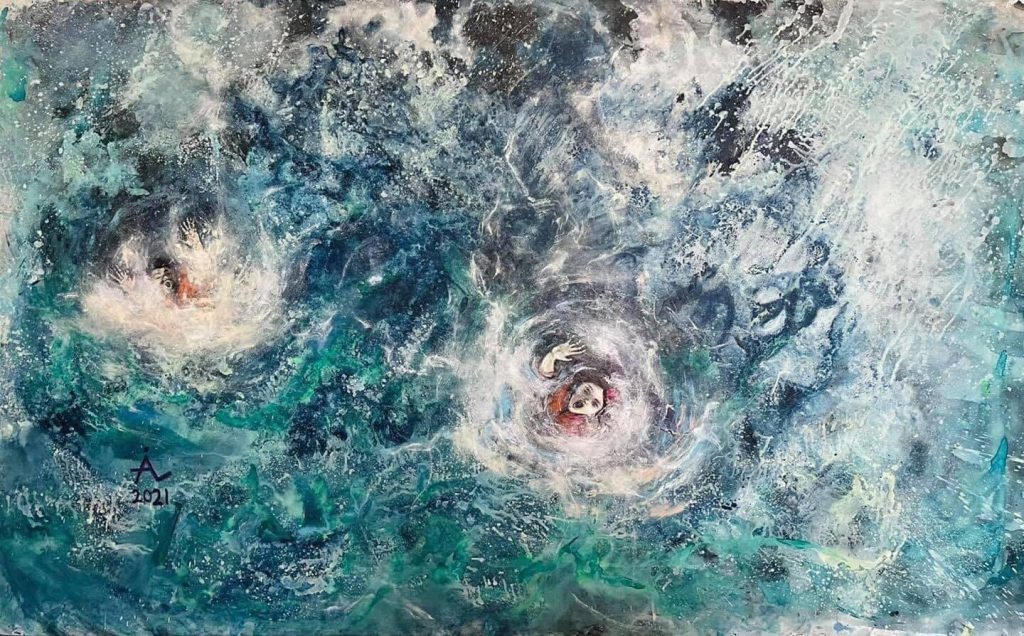4,947 Total views, 1 Views today
“We are such stuff as dreams are made on, and our little life is rounded with a sleep.”
(Prospero, in The Tempest)
by Fiona Crouch
It is now acknowledged that the process of dreaming, not just sleeping, is important to a person’s wellbeing. In a 2017 article, Matthew Walker[1] describes it as ‘overnight therapy’. The absence of any stress hormones while sleeping enable us to process and make meaning of difficult or traumatic memories. He highlights that dreams enhance our creativity and ability to solve problems.
So, why do I start a review of the art of Naz Ali Awla by talking about the importance of dreams?
The last few years have been tough in many ways and on many levels. In 2021, more so than ever, our souls need a balm to soothe and help remove us from the chaos and destruction that engulfs us from all directions. The first time I saw Naz’s work, I felt myself exhale, truly exhale, for the first time in many months. The blue undertones that feature in many of her paintings transported me to a dream world, a utopia, where the trials and tribulations of life seem a long way away. The ability of art to relax and empower us to look at our lives through a different lens is powerful.

Yet, as well as inducing an air of somnolence, the blue of many of Naz’s artwork is bold and vibrant. Her use of this colour, while exuding tranquillity, hints at the duality of our lived experience. Blue is usually regarded as the colour of relaxation, serenity, spiritual realization. I feel this in all of her paintings. However, the blue also portrays the intimation of foreboding; an unidentifiable danger that lurks beneath the calm exterior. Is this the threat, even reality, of powers we humans are unable to control, such as an angry, turbulent sea or the menace we sense approaching under the cloak of darkness? Despite our self-declared supremacy, humans remain unable to control much of the world around us. Moreover, what does the natural world owe us? We are responsible for many of the perils that threaten our future and that of our planet.
Even in the face of danger, ours is a world full of wonder. Through her paintings, there is a connection to nature in all its magnificence and strength. In Naz’s art, we are able to feast our eyes on rich flora and fauna. She shows us women dancing or they stare boldly from the canvases that give them life. For me, these women are representations of Mother Nature who is personified in their faces, bestowing us all with the power of Her femininity.
As a mother to young children, Naz will be determined to nurture and protect them. Through her artwork she creates glimpses of make-believe, a fairy tale world that enchants every spectator, while simultaneously recalling the innocence of childhood. In many pieces, I felt transported to Peter Pan’s Neverland with Tinkerbell and her fae kin appearing as little flecks of light. But, Neverland was also a place of danger, somewhere Mrs Darling rightly feared. In her art, Naz acknowledges but keeps the insinuation of danger at bay. Instead the overwhelming emotion is love; every piece is suffused with love. Through her paintings, Naz presents the reality of motherhood; your wish for them to follow their dreams and hearts, interspersed with the nagging fear that they will be hurt in their quest and that you may be powerless to always keep them safe.
It follows that Naz’s paintings contain a lyrical quality – a hint of a story underpinning and inspiring each piece. She grew up in a family of readers, surrounded by books and literature. I can imagine her curled up with a book, her mind chasing thoughts of faraway magical lands. Although she is a prolific author, especially of poetry, she prefers to keep her writing to herself. She acknowledges that literature has helped expand her own artistic imagination and is an essential ingredient of her paintings. This side to her creativity peeps out from her work; further suggestions, here and there, of the artist’s hidden depths. These hidden depths gift Naz the rare artistic skill of being able to convey movement, of taking the viewer on a journey, whether that is drifting in water or floating through a nightscape. While I gaze at her paintings, I often catch myself swaying backwards in forwards, joining in with the rhythm that I imagine her characters are moving to. I try to shake myself free, but Naz’s art has captured me, body and mind, and I find myself being transported to her world of dreams. I am powerless to resist…

This article was dedicated ‘To all those who have lost their lives crossing angry, turbulent seas in their quest to find safety and a new home’.
[1] https://greatergood.berkeley.edu/article/item/why_your_brain_needs_to_dream














